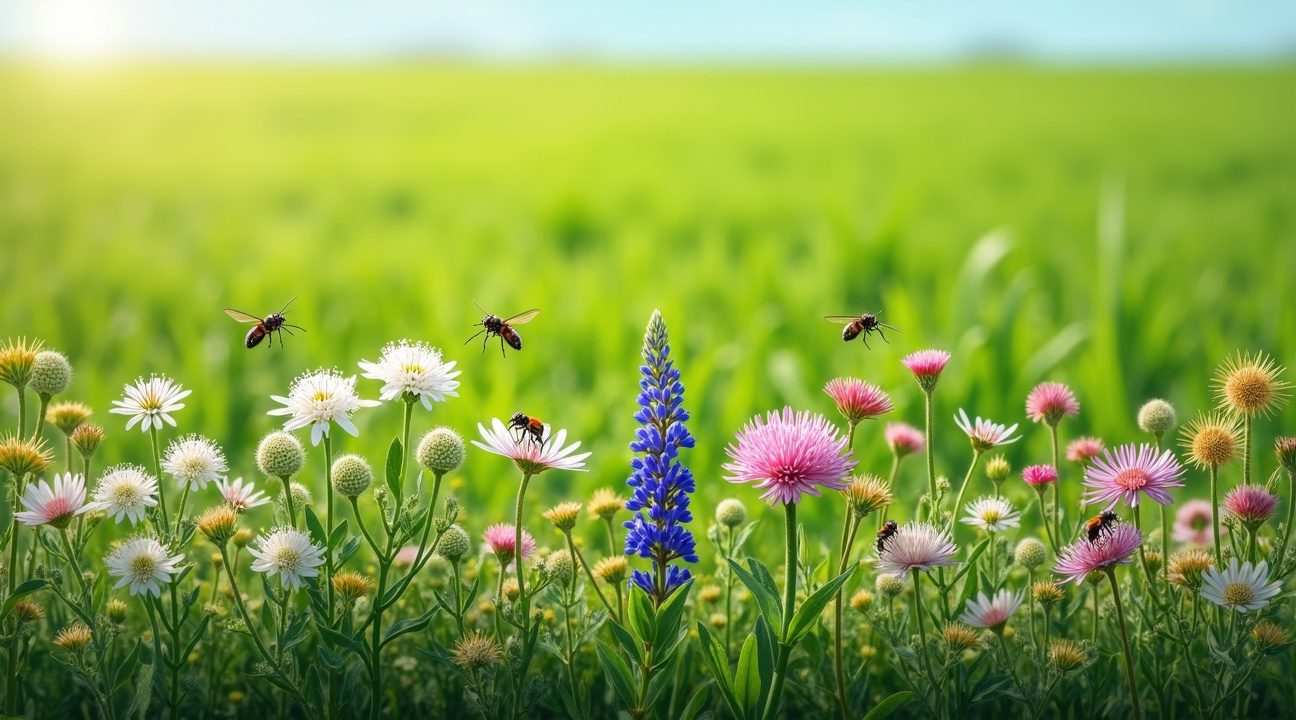Farmers across multiple continents are reaping impressive benefits from strategically planted wildflower strips, both reducing their reliance on pesticides and improving pest control effectiveness.
Key Takeaways
- Wildflower strips dramatically reduce pest populations, with studies showing 40–66% reductions in cereal leaf beetle larvae and a 53% decrease in adult populations compared to control fields.
- Financial benefits reach £3,000 per hectare annually for apple farmers who transition from chemical pesticides to wildflower strip systems, saving significantly on pesticide purchases and application costs.
- Three key species drive peak results: buckwheat, coriander, and cornflower offer vital floral resources during May-June, a critical period when beneficial insects require the most nutritional support.
- Perennial strips outperform annual plantings, yielding a 44% reduction in pest eggs and 66% in larvae, with effects extending up to 20 meters into adjacent crop fields.
- Benefits extend beyond pest control: These strips also improve soil health through increased earthworm populations, boost pollinator diversity, and reinforce the overall resilience of agroecosystems.
These findings are supported by robust research that evaluated 868 different service-site-year combinations. The study not only confirms cost reductions but also validates the ecological benefits of incorporating wildflower diversity into agricultural systems.
Flower Strips Cut Crop Damage by 61% While Slashing Pest Populations
Wildflower strips deliver remarkable results in protecting crops from devastating pest damage. Research shows these floral borders enhance pest control services in adjacent fields by 16% on average, creating a natural defense system that rivals synthetic alternatives.
Dramatic Reduction in Cereal Leaf Beetle Populations
Annual flower strips demonstrate powerful effectiveness against cereal leaf beetle (CLB), one of agriculture’s most persistent threats. I’ve seen studies document a 40% reduction in CLB larvae and an impressive 53% decrease in second-generation CLB adults. Most importantly, crop plant damage caused by CLB dropped by 61% in fields with flower strips compared to control fields.
The numbers tell a compelling story about economic viability:
- CLB larvae populations fell from an average of 0.50 individuals per tiller to just 0.30 individuals per tiller.
- This reduction brings pest levels below the critical economic threshold of 0.4 larvae per tiller.
- This eliminates the need for costly chemical interventions.
Perennial Strips Deliver Superior Long-Term Protection
Perennial flower strips outperform their annual counterparts with even stronger pest suppression capabilities. These established plantings achieve a:
- 44% reduction in CLB eggs
- 66% reduction in larvae
- 40% reduction in crop damage in winter wheat
The extended lifespan of perennial strips allows beneficial insect populations to build up over multiple seasons, creating increasingly effective natural pest control.
The protective benefits extend well beyond the immediate border area. Pest control effects reach up to 20 meters into fields from the flower strips, creating substantial protection zones that cover significant crop acreage. This extended range means farmers can protect large field areas with strategically placed wildflower borders.
These dramatic pest reductions translate directly into improved crop yields and reduced input costs. Farmers eliminate multiple pesticide applications while maintaining superior crop protection. The natural approach also supports beneficial insect populations that provide ongoing pest suppression services throughout the growing season.
The consistent performance across different flower strip types demonstrates the reliability of this approach. Whether choosing annual or perennial varieties, farmers can expect significant pest reduction and crop protection benefits that often exceed conventional chemical control methods.

Apple Farmers Save £3,000 Per Hectare by Ditching Chemical Pesticides
Apple farmers across the country are discovering that wildflower strips aren’t just beautiful additions to their landscapes – they’re powerful money-saving tools that can slash production costs by up to £3,000 per hectare annually. This remarkable financial benefit stems from the strips’ ability to replace expensive chemical pesticides with nature’s own pest control system.
The economics behind this transformation are compelling. Traditional pesticide applications can cost farmers hundreds of pounds per hectare each season, with multiple treatments often required throughout the growing cycle. Wildflower strips eliminate much of this expense by creating habitats for beneficial insects that naturally control harmful pests. These predatory and parasitic insects work around the clock, providing continuous protection that chemical sprays simply can’t match.
Breaking Down the Financial Benefits
The £3,000 per hectare savings come from several sources that farmers can capitalize on immediately:
- Reduced pesticide purchases eliminate recurring chemical costs
- Lower application expenses save on fuel, equipment wear, and labor
- Decreased resistance development means existing treatments remain effective longer
- Improved soil health reduces the need for additional inputs
- Enhanced pollinator populations boost fruit set and quality
Flower strips function as a cost-effective tool by maintaining pest populations below economic thresholds – the point where pest damage costs more than the treatment itself. This natural balance means farmers don’t need to reach for expensive chemical solutions every time they spot a few aphids or mites. The beneficial insects living in the wildflower corridors quickly respond to pest outbreaks, often preventing them from reaching damaging levels.
Research shows that well-established flower strips can control up to 80% of common apple pests without any chemical intervention. This level of control makes them a viable alternative to insecticides for many farmers who previously thought organic approaches weren’t practical for commercial operations. The key lies in selecting the right mix of flowers that bloom throughout the growing season, ensuring beneficial insects have continuous food sources.
The economic threshold concept becomes particularly relevant when considering that many pest problems naturally resolve themselves given time. Chemical treatments often kill beneficial insects along with pests, creating a cycle where farmers need more frequent applications. Flower strips break this expensive cycle by preserving the natural predators that keep pest populations in check.
Smart farmers are integrating these strips strategically, placing them where they’ll have maximum impact on pest control while minimizing lost production area. A typical setup involves strips every 100–200 meters throughout the orchard, creating corridors that beneficial insects can use to move between areas. This design maximizes the pest control benefits while keeping the area dedicated to flowers relatively small.
Some operations have found that strategic planning around flower placement can enhance these savings even further. Timing the establishment of these strips with orchard renovation or expansion projects spreads the initial costs over multiple seasons while building long-term pest management infrastructure.
The transition period typically takes 2–3 years for flower strips to reach full effectiveness, but farmers often see reduced pesticide needs within the first growing season. Early adopters report that the strips pay for themselves through reduced chemical costs alone, with the £3,000 per hectare figure representing sustained annual savings once the system matures.
Weather resistance also factors into the economic equation. Unlike chemical pesticides that wash away in heavy rain or lose effectiveness in extreme temperatures, flower strips provide consistent pest control regardless of conditions. This reliability means farmers can count on their pest management system working when they need it most, reducing the risk of crop losses that could devastate profitability.
Modern apple production demands efficiency at every level, and wildflower strips deliver exactly that by turning pest management from a recurring expense into a self-sustaining asset that generates returns year after year.
How Flower Strips Transform Beneficial Bug Populations
Wildflower strips act as powerful magnets for beneficial insects, dramatically boosting populations of natural enemies that farmers desperately need. These carefully planted corridors create thriving ecosystems where predatory species flourish, offering farmers a biological alternative to chemical pest control methods.
Dramatic Population Increases in Key Predator Species
Research demonstrates that natural enemies experience significant population boosts both within flower strips and in adjacent wheat fields. Ground beetles, predatory bugs, and lacewings show the strongest positive responses to these planted corridors, with all observed natural enemies (except larvae) displaying highly increased numbers inside flower strips compared to wheat control strips.
Ground beetles become particularly abundant in these areas, patrolling the soil surface and consuming countless pest insects throughout the growing season. Predatory bugs establish themselves in the diverse plant structure, while lacewings use the flowers as both hunting grounds and nurseries for their offspring. This population explosion creates a natural army of pest controllers that work around the clock.
Essential Habitat Services for Beneficial Insects
Flower strips function as comprehensive support systems for beneficial bug populations by providing four critical habitat components:
- Shelter: Reliable protection from harsh weather conditions and agricultural disturbances, safeguarding insects during key life stages.
- Oviposition sites: Perfectly structured areas where predators can lay eggs safely, enhancing offspring survival.
- Overwintering opportunities: Microhabitats within plant debris and varied vegetation help beneficial insects survive the winter months.
- Food resources: Nectar and pollen from flowering plants sustain adult insects, fueling reproduction and predation.
The biodiversity enhancement that results from these strategic plantings creates a ripple effect throughout the agricultural landscape. Predator populations stabilize at higher levels, providing consistent biological pest control that reduces the need for chemical interventions. Farmers who implement flower strip programs often discover that pest management becomes more predictable and sustainable over time.
This transformation of beneficial bug populations represents a fundamental shift in agricultural pest management, where farmers work with natural processes rather than against them. The enhanced biodiversity creates resilient ecosystems that continue delivering pest control benefits year after year.

The Science Behind Effective Flower Strip Design
Strategic flower strip design relies on specific scientific principles that maximize ecological benefits while reducing pesticide dependency. Research reveals that perennial plantings consistently outperform annual installations, with older flower strips demonstrating enhanced pollination services compared to newly established ones. This superior performance stems from the time required for beneficial insect populations to discover, colonize, and establish stable communities within these habitats.
Flowering plant diversity emerges as a critical factor in strip effectiveness. Fields bordered by species-rich flower strips attract and support a higher diversity of natural enemies than those with species-poor or single-species plantings. These diverse communities create multiple pathways for pest control, as different beneficial insects target various crop pests throughout growing seasons.
Distance proves crucial in determining strip impact, with pollination services declining exponentially as measurements move away from flower plantings. This finding emphasizes the importance of strategic placement, suggesting farmers should position strips close to crops requiring pollination services for maximum benefit.
Landscape Context and Strip Performance
Comprehensive studies examining sites across gradients of landscape complexity, ranging from 8–75% non-crop area, reveal fascinating insights about strip performance. Flower strip effects on natural enemies, pests, and crop damage remain largely independent of landscape complexity. This independence means that even farms in simplified agricultural landscapes can achieve significant benefits from well-designed flower strips.
The most effective strips incorporate carefully selected plant species that provide three distinct resource types:
- Floral resources supply nectar and pollen for adult beneficial insects
- Extra-floral resources offer alternative food sources like aphid honeydew
- Structural resources provide overwintering sites and nesting materials
Modern agricultural research demonstrates that strategic planning in flower strip composition yields measurable results. Species selection should prioritize native plants that bloom sequentially throughout growing seasons, ensuring continuous resource availability for beneficial insects.
Farmers implementing science-based flower strip designs report reduced pesticide applications without compromising crop yields. These strips function as biological infrastructure, supporting pest management while enhancing farm biodiversity. The exponential decline pattern of benefits with distance reinforces the need for multiple strips across larger fields rather than single, isolated plantings.
Three Plant Species Drive Peak Pest Control Results
I’ve observed through research that three specific wildflower species consistently deliver exceptional pest control benefits when farmers establish flower strips alongside their agricultural fields. Fagopyrum esculentum (buckwheat), Coriandrum sativum (coriander), and Centaurea cyanus (cornflower) emerge as the champions of floral resource provisioning during the critical May and June period when pest pressure typically peaks.
Strategic Timing Maximizes Natural Enemy Support
Buckwheat, coriander, and cornflower don’t just provide pretty borders for crop fields—they function as strategic biological weapons against agricultural pests. These three species bloom precisely when beneficial insects need nutritional support most. During May and June, crop pests reach their highest activity levels, making this the most crucial window for natural enemy effectiveness.
Farmers implementing these wildflower strips discover that timing matters enormously. Buckwheat’s rapid germination and early flowering capability makes it particularly valuable for providing immediate nectar sources. Coriander follows with its umbrella-shaped flower clusters that attract diverse beneficial insects, while cornflower’s vibrant blue blooms extend the flowering period and support different natural enemy species.
Complementary Resources Support Diverse Beneficial Insects
The success of these three species stems from their ability to provide staggered and complementary resources. Different natural enemy groups require different types of nutritional support throughout the growing season. This diversity approach proves far more effective than relying on single-species plantings.
Each species offers unique benefits that address specific natural enemy needs:
- Buckwheat produces abundant nectar in easily accessible shallow flowers, perfect for small parasitic wasps and hover flies
- Coriander‘s compound flower heads provide both nectar and pollen resources that support larger beneficial insects like lacewings and predatory beetles
- Cornflower delivers long-lasting blooms with high-quality nectar that sustains natural enemies through extended periods
- The combination creates overlapping flowering periods that eliminate resource gaps throughout the pest control season
- Multiple flower types accommodate different insect mouthpart structures and feeding preferences
This staggered provision ensures that beneficial insects find consistent food sources from early spring through late summer. Rather than experiencing boom-and-bust cycles that force natural enemies to migrate elsewhere, the three-species combination maintains stable populations right where farmers need them most.
Smart farmers recognize that successful pest management requires thinking beyond individual plant performance. The synergy between buckwheat, coriander, and cornflower creates a comprehensive support system for beneficial insects. Each species contributes floral resources at different times and in different forms, ensuring that various natural enemy groups find exactly what they need when they need it.
Practical implementation involves planting these species in strips ranging from 3 to 6 feet wide along field margins. The combination approach eliminates guesswork about which single species might work best in specific locations. Instead, the three-species mix adapts to local conditions while providing insurance against individual species failures due to weather or soil variations.
Research consistently demonstrates that farms using this targeted three-species approach achieve better pest control results than those relying on random wildflower mixes or single-species plantings. The strategic selection of buckwheat, coriander, and cornflower reflects years of scientific observation about which plants deliver maximum biological control benefits during peak pest pressure periods.
Modern agriculture benefits tremendously from this evidence-based approach to beneficial habitat creation. By focusing on proven performers rather than experimental combinations, farmers can confidently invest in wildflower strips knowing they’ll see measurable pest reduction results. The three-species strategy transforms what might otherwise be unproductive field margins into active contributors to crop protection and farm profitability.

Beyond Pest Control: Flower Strips Boost Soil Health and Biodiversity
Flower strips create remarkable ripple effects throughout agricultural ecosystems that extend far beyond their primary pest control function. Data compiled from 35 studies reveals compelling evidence across 868 service-site-year combinations and 529 sites spanning North American, European, and New Zealand agroecosystems. These findings demonstrate how perennial flower strips strongly promote earthworm populations, which subsequently enhance soil functions and benefit higher trophic taxa throughout the agricultural landscape.
Enhanced earthworm activity transforms soil structure and nutrient cycling in ways that directly impact crop productivity. When farmers establish annual flower strips along field edges, they create habitat corridors that support these beneficial soil organisms year-round. The increased earthworm populations improve water infiltration, organic matter decomposition, and nutrient availability for crops. This natural soil enhancement reduces the need for synthetic fertilizers while building long-term soil health.
Expanding Ecological Benefits
Flower strips locally increase both abundance and diversity of pollinators and natural enemies, creating a comprehensive support system for agricultural production. Research shows that these conservation biological control measures function as ecological intensification strategies that work alongside modern farming techniques. The flower strips serve as refugia during pesticide applications and provide consistent nectar and pollen sources throughout growing seasons.
Hedgerows and flower strips rank among the most commonly implemented ecological intensification measures because they deliver measurable results. Farmers can establish these features without removing productive land from cultivation, making them economically viable conservation tools. The effectiveness of carefully designed agri-environment schemes demonstrates high potential to contribute to sustainable farming practices while maintaining crop yields.
Implementation Strategies
Studies demonstrate that properly designed flower strips offer a viable alternative to frequent insecticide applications. Successful implementation requires strategic planning that considers:
- Local pollinator species and their preferred flowering periods
- Native plant selections that support regional beneficial insects
- Strip width and placement for maximum pest control effectiveness
- Maintenance schedules that preserve habitat quality
- Integration with existing crop rotation systems
The research emphasizes that ecosystem services multiply when farmers adopt these comprehensive approaches. Flower strips enhance pollination services, natural pest control, and soil health simultaneously, creating synergistic benefits that strengthen overall farm resilience. These conservation strategies prove particularly effective when implemented as part of broader sustainable agriculture programs that recognize the interconnected nature of agricultural ecosystems.

Sources:
National Institutes of Health – “Biological pest control and pollination in agriculture are mediated by biodiversity”
National Institutes of Health – “Ecological intensification and agriculture: Increasing food production while reducing environmental impacts”
Wiley Online Library – “The effects of flower strips on biological pest control, pollination services, and yield in European agricultural landscapes”
University of Reading – “Flower strips could save apple farmers £3,000 a hectare in pest control costs”
Nature – “Tailored flower strips promote natural enemy biodiversity and pest control in agricultural landscapes”
U.S. Environmental Protection Agency HERO – “An evidence-based framework to inform generalized management of ecosystem services in agriculture”


